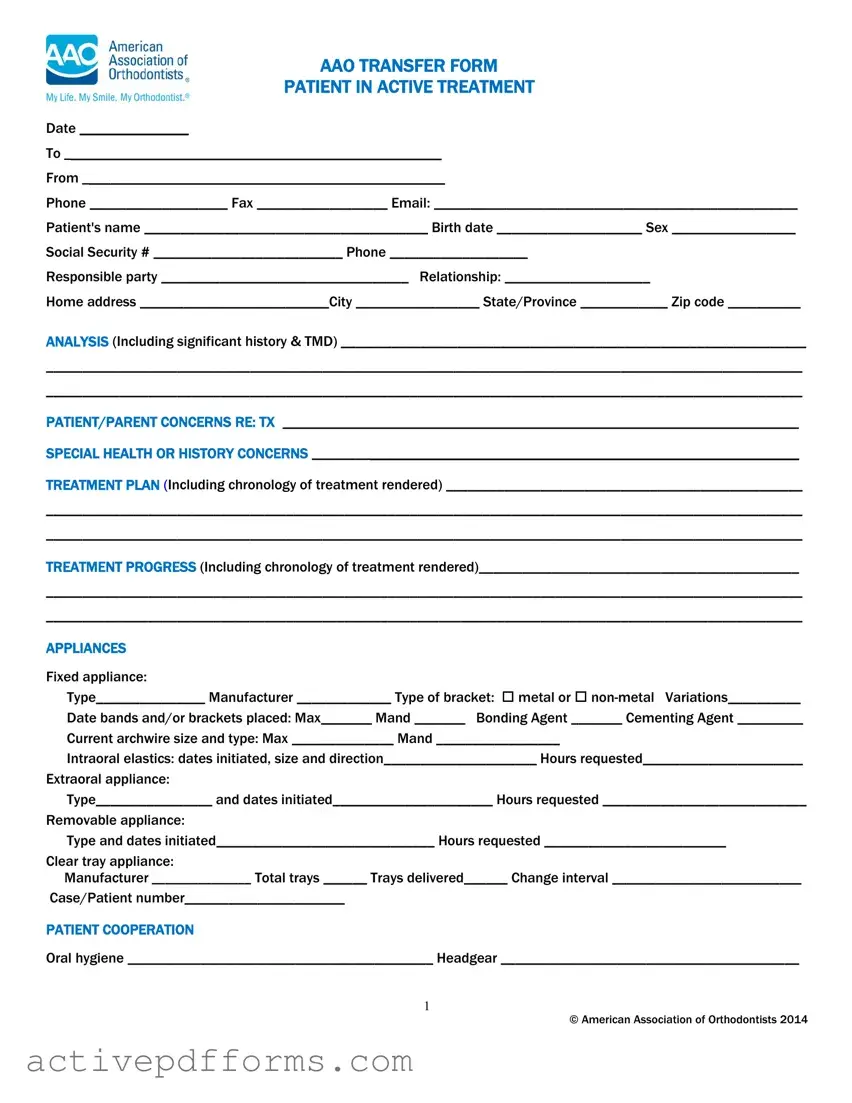AAO TRANSFER FORM
PATIENT IN ACTIVE TREATMENT
Date _______________
To ____________________________________________________
From __________________________________________________
Phone ___________________ Fax __________________ Email: __________________________________________________
Patient's name _______________________________________ Birth date ____________________ Sex _________________
Social Security # __________________________ Phone ___________________
Responsible party __________________________________ Relationship: ____________________
Home address __________________________City _________________ State/Province ____________ Zip code __________
ANALYSIS (Including significant history & TMD) ________________________________________________________________
________________________________________________________________________________________________________
________________________________________________________________________________________________________
PATIENT/PARENT CONCERNS RE: TX _______________________________________________________________________
SPECIAL HEALTH OR HISTORY CONCERNS ___________________________________________________________________
TREATMENT PLAN (Including chronology of treatment rendered) _________________________________________________
________________________________________________________________________________________________________
________________________________________________________________________________________________________
TREATMENT PROGRESS (Including chronology of treatment rendered)____________________________________________
________________________________________________________________________________________________________
________________________________________________________________________________________________________
APPLIANCES
Fixed appliance:
Type_______________ Manufacturer _____________ Type of bracket: metal or non-metal Variations__________
Date bands and/or brackets placed: Max_______ Mand _______ Bonding Agent _______ Cementing Agent _________
Current archwire size and type: Max ______________ Mand _________________
Intraoral elastics: dates initiated, size and direction_____________________ Hours requested______________________
Extraoral appliance:
Type________________ and dates initiated______________________ Hours requested ____________________________
Removable appliance:
Type and dates initiated______________________________ Hours requested _________________________
Clear tray appliance:
Manufacturer _______________ Total trays ______ Trays delivered______ Change interval __________________________
Case/Patient number______________________
PATIENT COOPERATION
Oral hygiene __________________________________________ Headgear _________________________________________
1
© American Association of Orthodontists 2014
Elastics ______________________________________________ Clear trays _______________________________________
Appointments _________________________________________ Broken appliances ________________________________
Patient's attitude toward treatment ________________________________________________________________________
Suggestions for patient motivation _________________________________________________________________________
ACTIVE TX TIME ESTIMATES Original _________________________ Remaining _____ % of active treatment completed
RECOMMENDATIONS FOR CONTINUED TREATMENT __________________________________________________________
______________________________________________________________________________________________________
RECOMMENDATIONS FOR RETENTION _____________________________________________________________________
ADDITIONAL COMMENTS _______________________________________________________________________________
_____________________________________________________________________________________________________
FINANCIAL
Closed ______________ Open End (Fixed) _______________Other ______________________
Fees: Active _______________ Extras ______________________________________________
Terms ________________________________________________________________________
Third party payment ____________________________________________________________
Total charges before transfer _________________________
Total amount paid before transfer _____________________
Unpaid amount still owed transferring office ____________
Balance of original quoted fee not yet charged ______________ or overpaid at transfer ______________
This patient/parent has been advised that orthodontic treatment fees vary widely throughout the country and the world and it is reasonable for them to expect that a transfer may increase treatment fees and may involve changes in payment policies. For most people who transfer during their orthodontic treatment, the total treatment cost is likely to increase.
AVAILABLE RECORDS FOR TRANSFER |
|
Casts |
Initial |
Date ________ |
Progress Date ________ Articulator type________ |
Ceph |
Initial Date ________ |
Progress Date ________ |
Tracings |
Initial |
Date ________ |
Progress Date ________ |
Panoramic |
Initial Date ________ |
Progress Date ________ |
CBCT |
Initial Date ________ |
Progress Date ________ |
Intra-oral scan |
Initial |
Date ________ |
Progress Date ________ |
files |
|
|
|
Intraoral x-rays |
Initial |
Date ________ |
Progress Date ________ |
Facial photos |
Initial Date ________ |
Progress Date ________ |
Intraoral photos |
Initial Date ________ |
Progress Date ________ |
Check appropriate status of records:
Record duplicates sent upon request (may be an additional charge to patient) Yes No
Records enclosed Yes No Records sent under separate cover Yes No
Signature: __________________________________________________Date_______________________
(Orthodontist)
2
© American Association of Orthodontists 2014
REQUEST TO TRANSFER RECORDS TO NEW PROVIDER
When a patient moves, or, for other reasons, there is a necessity to change orthodontists during the course of ongoing orthodontic treatment, it is highly advantageous for all involved parties that the transfer be as prompt and convenient as possible. Of paramount importance is the identification of an orthodontist who will accept the patient and successfully complete the treatment.
The American Association of Orthodontists represents over ninety percent of the orthodontic specialists in the U.S. and Canada. Your current doctor is a member and will assist you in finding a qualified orthodontist.
It is necessary that your records be transferred to assure that the receiving orthodontist is knowledgeable of your orthodontic condition(s), orthodontic treatment goals, the current treatment plan, and related financial arrangements. To facilitate the transfer of these records, it is necessary that you complete the following:
I authorize Dr. ____________________ to release all records of ____________________ (patient’s name) for the
purpose of continuation of treatment by Dr. ___________________(new provider’s name).
Signature: __________________________________________________________Date_______________________
(Patient or Guardian)
Print Name ________________________________________
Relationship to Patient ______________________________
3
© American Association of Orthodontists 2014

